With so many freelancing platforms available in 2025, there’s something for everyone, whether you’re a seasoned professional or just starting your freelancing journey. Explore these platforms to find the one that aligns best with your skills, goals, and industry. Ready to take your freelancing career to the next level? While keeping it short and simple, start by signing up for one of these platforms today!
1.Upwork

- Get started: Visit Upwork
- Pros:
- + Large variety of job categories.
- + Payment protection for both parties.
- + Flexible contracts (hourly or fixed).
- Cons:
- – High competition for freelancers.
- – 10-20% service fees can be costly.
Upwork is one of the most popular freelancing platforms, offering a vast variety of job categories ranging from writing and graphic design to software development and marketing.
The platform is an excellent choice for freelancers seeking flexible contracts, as you can negotiate hourly rates or fixed-price projects depending on your preferences. Additionally, Upwork provides payment protection, ensuring you get paid for your work once the agreed terms are met, which is a big plus for freelancers and clients alike.
The platform also features a robust messaging system, time tracking, and milestone-based payment structures to make collaboration smoother. However, with its large user base, competition can be fierce, and freelancers often need to refine their profiles and proposals to stand out. Upwork’s service fees, ranging from 10-20%, can also reduce your overall earnings.
Despite these drawbacks, the platform remains an excellent choice for finding reliable freelance work, especially for those looking for long-term collaborations or diverse opportunities in one place. With its wide range of clients and projects, Upwork is a great way to grow your career, build relationships with global clients, and secure consistent work opportunities.
2. Fiverr
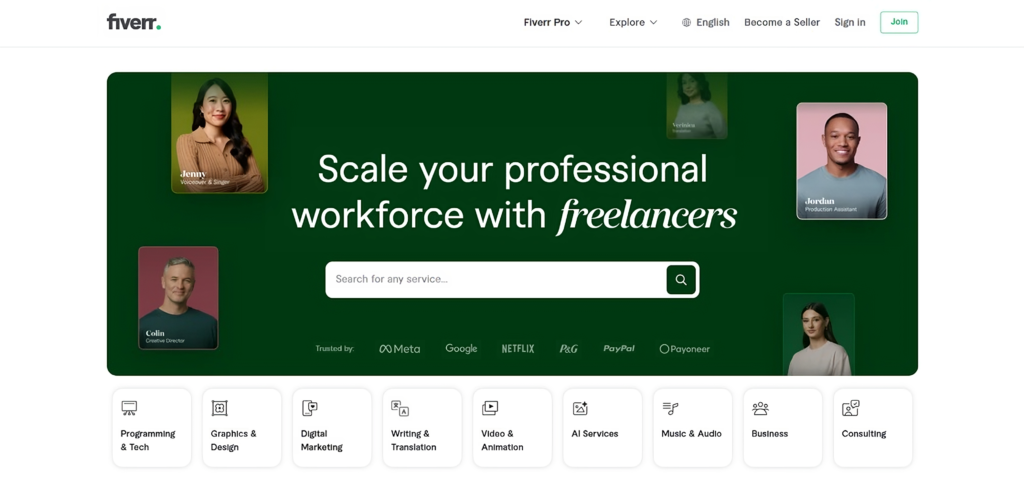
- Get started: Visit Fiverr
- Pros:
- + Freelancers set their prices and gigs.
- + User-friendly interface for quick transactions.
- + Great for short-term or micro-tasks.
- Cons:
- – Limited negotiation; clients may focus on cheap gigs.
- – Fiverr takes 20% of every payment.
Fiverr is a user-friendly platform designed to connect freelancers with clients for micro-tasks and short-term projects.
One of its key strengths is the ability for freelancers to create “gigs,” allowing you to define your services, set prices, and even offer package deals. This flexibility is ideal for those who want to work on their terms without being tied to a rigid job structure.
Fiverr is perfect for creatives offering services like graphic design, content writing, or video editing. Its interface is intuitive, making it easy for beginners and seasoned freelancers to navigate. However, the platform’s focus on low-cost gigs can sometimes lead to clients undervaluing work, and the 20% service fee on all transactions is relatively high.
Despite these challenges, Fiverr remains a great choice for freelancers who want to start small and gradually build their reputation. It’s also an excellent option if you’re looking to experiment with new services or niche offerings. The platform’s simplicity, combined with its potential to earn steady income, makes it an appealing choice for many freelancers.
3. Toptal

- Get started: Visit Toptal
- Pros:
- + Elite talent pool due to rigorous screening.
- + High-quality clients with well-paying projects.
- + Focus on top-tier developers, designers, and finance experts.
- Cons:
- – Limited to experienced professionals.
- – Harder for newcomers to enter.
Toptal is a premium freelancing platform aimed at experienced professionals. It specializes in connecting top-tier talent with high-quality clients across industries like software development, finance, and design.
The platform boasts a rigorous screening process that ensures only the top 3% of applicants are accepted, making it a haven for elite freelancers.
Toptal is an excellent choice for those who want to work with industry-leading companies and secure well-paying projects. Because the platform prioritizes quality over quantity, freelancers often find themselves working on meaningful, impactful tasks. However, this exclusivity also means it’s not suitable for beginners or those looking for smaller projects.
The application process can be lengthy and competitive, but for those who qualify, Toptal offers a reliable and high-paying avenue for freelance work. Its strong focus on professional growth, combined with access to exceptional clients, makes it a great platform for advancing your career in a specialized field.
4. Freelancer
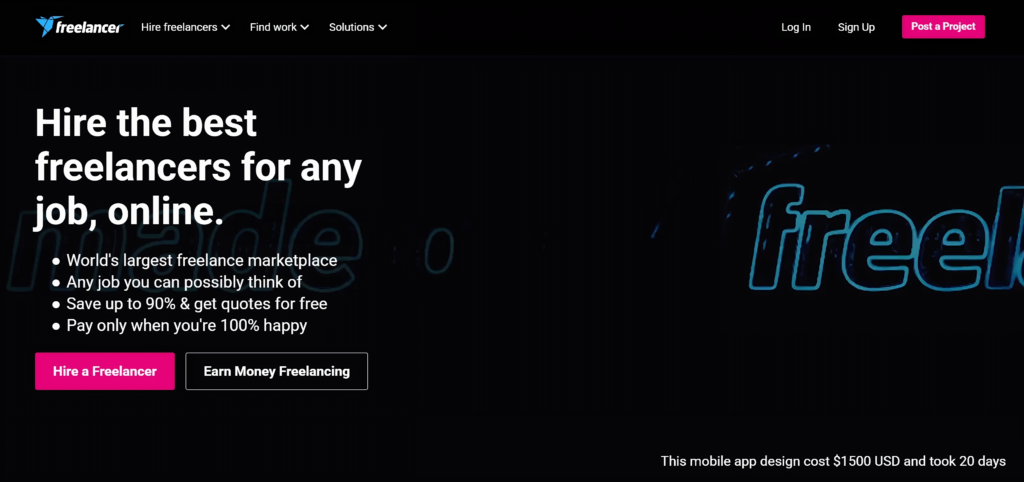
- Get started: Visit freelancer
- Pros:
- + Wide range of job categories.
- + Option to participate in contests for creative tasks.
- + Milestone-based payments.
- Cons:
- – High fees (up to 10-20%).
- – Clients may favor low-cost bids, leading to price undercutting.
Freelancer is a versatile platform that caters to a wide array of industries, from writing and design to engineering and marketing.
One of its unique features is the ability to participate in contests, where freelancers can showcase their skills and win projects based on their submissions. This is particularly appealing for creative professionals looking to build their portfolios.
Freelancer also offers milestone-based payments, providing security for both freelancers and clients during ongoing projects. However, the platform’s high fees—up to 10-20%—can be a drawback, especially for beginners. Additionally, competition is intense, as many clients prioritize cost-effective bids, leading to price undercutting.
Despite these challenges, Freelancer’s diverse job categories and flexible payment options make it a solid choice for freelancers looking to explore various industries. It’s especially beneficial for those who enjoy the challenge of competing in contests and are willing to adapt to a competitive marketplace.
5. PeoplePerHour
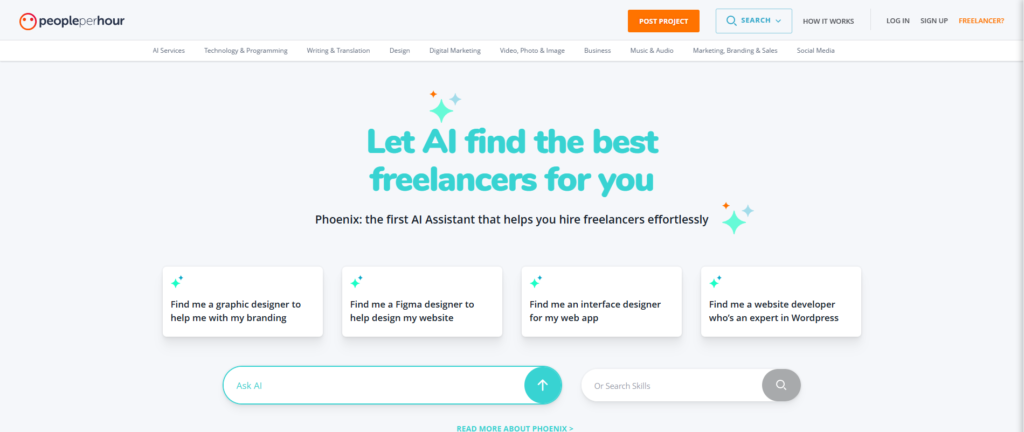
- Get started: Visit peopleperhour
- Pros:
- + Suitable for small to medium-sized projects.
- + Good for freelancers seeking part-time work.
- + Payment protection with escrow.
- Cons:
- – Fees are on the higher side (20% for the first $350).
- – Fewer high-budget jobs compared to platforms like Upwork.
PeoplePerHour is an ideal platform for freelancers seeking small to medium-sized projects. The site’s focus on part-time work and its user-friendly interface make it particularly appealing for those who want to balance freelancing with other commitments.
One of its standout features is payment protection via escrow, ensuring both clients and freelancers are safeguarded during transactions. Freelancers can also create hourly offers, which makes pricing transparent and straightforward. However, PeoplePerHour charges a high service fee of 20% for the first $350 earned, which can be discouraging for newcomers. The platform also has fewer high-budget projects compared to competitors like Upwork, making it more suitable for smaller-scale tasks.
Despite these limitations, PeoplePerHour remains a great option for freelancers who prefer a more niche and manageable workload. Its focus on trust and transparency, combined with a solid range of opportunities, makes it a reliable platform for building a steady freelance career.
6. Guru
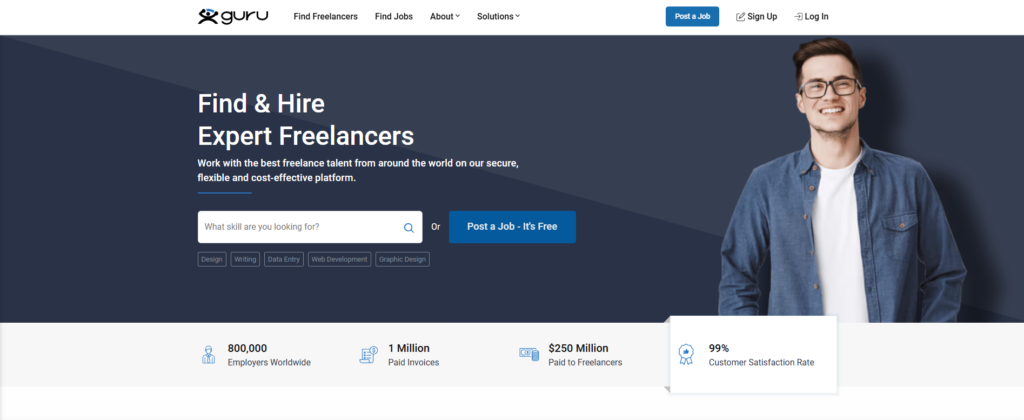
- Get started: Visit guru
- Pros:
- + Multiple payment options (hourly, milestone, task-based).
- + Low service fees (as low as 5%).
- + Decent collaboration tools.
- Cons:
- – Smaller client base compared to Upwork or Fiverr.
- – Less intuitive user interface.
Guru is one of the largest freelance marketplaces, with over two million freelancers and 800,000 employers on its platform. It’s a versatile option for finding experts across a variety of fields, including programming, design, writing, sales, and engineering.
One of Guru’s strongest features is its freelancer verification system, which ensures clients are hiring legitimate professionals. The platform also provides multiple payment options, such as hourly rates, task-based rates, milestones, and recurring payments, making it flexible for all kinds of projects. Guru’s collaboration tools, like its built-in dashboard, make project management easier for freelancers and employers. Another advantage is its relatively low service fees, which can go as low as 5%—significantly lower than many competitors. However, the smaller client base compared to platforms like Upwork or Fiverr may mean fewer opportunities for freelancers.
Additionally, the platform’s interface is less intuitive, which can be a drawback for newcomers. Despite these challenges, Guru’s secure payments, flexible pricing structures, and large database of professionals make it an excellent option for freelancers seeking diverse opportunities. Paid memberships offer additional perks, such as reduced fees and enhanced visibility, making Guru a platform worth considering for serious freelancers.
7. SimplyHired
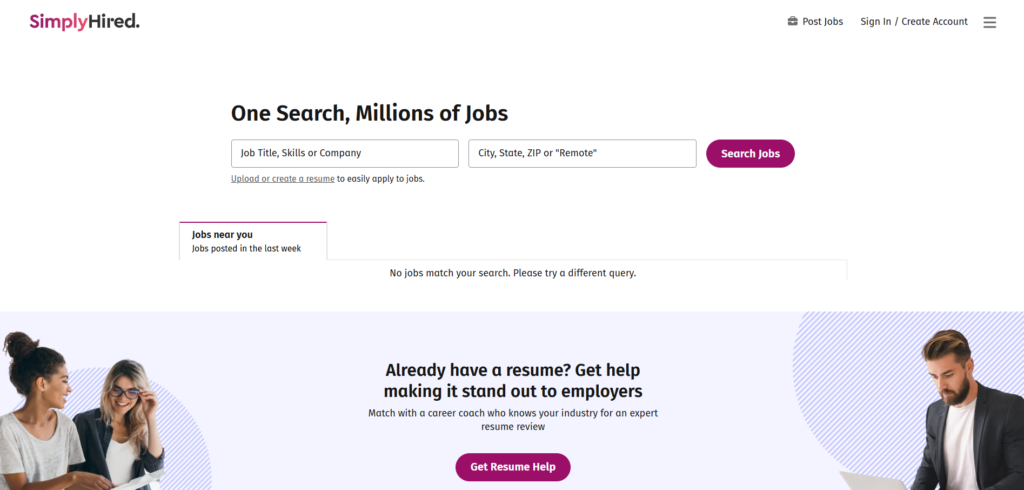
- Get started: Visit simplyhired
- Pros:
- + Aggregates freelance opportunities from multiple sources.
- + Easy to navigate with a simple interface.
- + Wide range of industries covered.
- Cons:
- – No direct freelancing features like escrow or contracts.
- – More suited for job hunting than freelancing.
SimplyHired is a job aggregation platform that pulls freelance opportunities from various sources, making it an excellent choice for freelancers looking to expand their job search beyond traditional platforms.
The site covers a wide range of industries, from healthcare and education to technology and marketing. Its simple and easy-to-navigate interface makes browsing and applying for jobs straightforward, even for beginners. SimplyHired is also free to use, which is a big advantage compared to other platforms that charge subscription or service fees. However, the platform lacks direct freelancing features like escrow services or built-in contracts, which means freelancers and clients must handle payment and project management independently. Additionally, SimplyHired is more suited for job hunting than freelancing, as many listings are for full-time or part-time employment rather than project-based work.
Despite these limitations, the platform’s wide range of opportunities and its aggregation model make it a valuable resource for freelancers looking to diversify their search. It’s particularly useful for finding freelance-friendly roles in industries where dedicated freelance platforms may have limited coverage.
8. 99designs

- Get started: Visit 99designs
- Pros:
- + Excellent for freelance designers.
- + Contests provide exposure to multiple clients.
- + High-quality clients with creative demands.
- Cons:
- – Earnings depend on contest wins.
- – No support for non-design freelancers.
99designs is the go-to platform for freelance designers seeking creative opportunities. Specializing in graphic design, branding, and visual projects, it’s a great option for those looking to connect with high-quality clients.
The platform allows designers to participate in contests, which provide exposure to multiple clients and the chance to win paid projects. This makes 99designs particularly appealing for designers who are confident in their skills and want to build their portfolios. Clients are typically willing to pay premium prices for top-notch designs, which can result in higher earnings for freelancers.
However, the platform’s earnings model heavily depends on contest wins, which means you may put in effort without guaranteed payment. Additionally, 99designs is exclusively for designers, so it’s not a suitable choice for freelancers in other fields.
Despite these drawbacks, 99designs is an excellent platform for designers who thrive in competitive environments and are looking to work with creative, high-quality clients. Its focus on design excellence and creative collaboration makes it a unique option in the freelance marketplace.
9. Linkedin
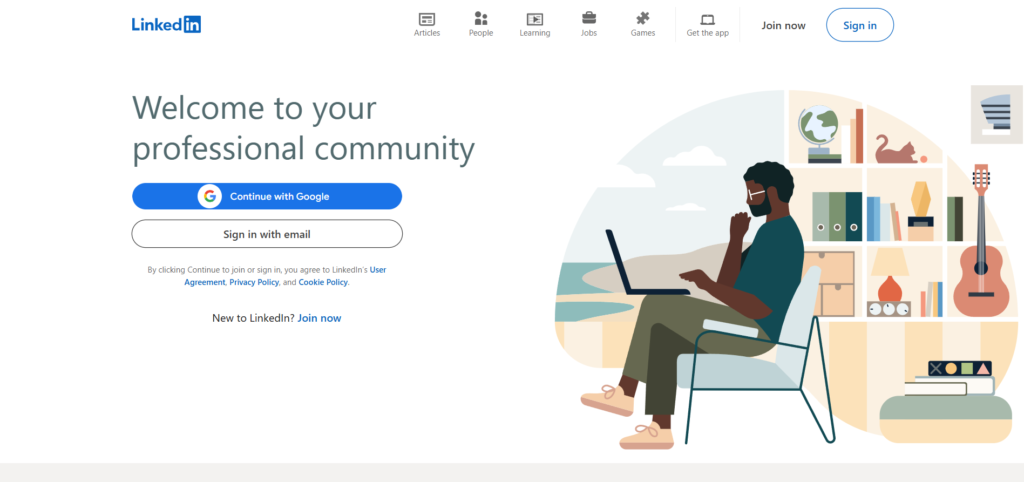
- Get started: Visit linkedin
- Pros:
- + Professional networking connects you with clients, recruiters, and businesses.
- + Built-in portfolio lets you showcase your work, skills, and recommendations.
- + Diverse opportunities include freelance, remote, part-time, and full-time roles.
- Cons:
- – Not primarily freelance-focused, making gig searching more effortful.
- – High competition as jobs attract many applicants.
- – LinkedIn Premium may be needed for better visibility and job access.
LinkedIn is a professional networking platform that doubles as a job search site, making it a great option for freelancers who want to connect directly with potential clients and employers.
Unlike traditional freelance platforms, LinkedIn allows you to showcase your skills, portfolio, and recommendations directly on your profile. This transparency helps build trust and credibility with clients. The platform offers diverse opportunities, including freelance, remote, part-time, and full-time roles, across virtually all industries. LinkedIn’s built-in networking features let you establish relationships with decision-makers and recruiters, often leading to direct freelance opportunities. However, finding freelance work on LinkedIn can be more effortful than on platforms dedicated to freelancing, as it’s not primarily focused on gig work.
High competition is another drawback, as jobs often attract numerous applicants. Additionally, upgrading to LinkedIn Premium may be necessary to access advanced job search features and improve visibility, which comes at a cost. Despite these challenges, LinkedIn’s professional credibility, networking opportunities, and ability to connect with high-quality clients make it an indispensable tool for freelancers looking to grow their careers.
10. Flexjobs
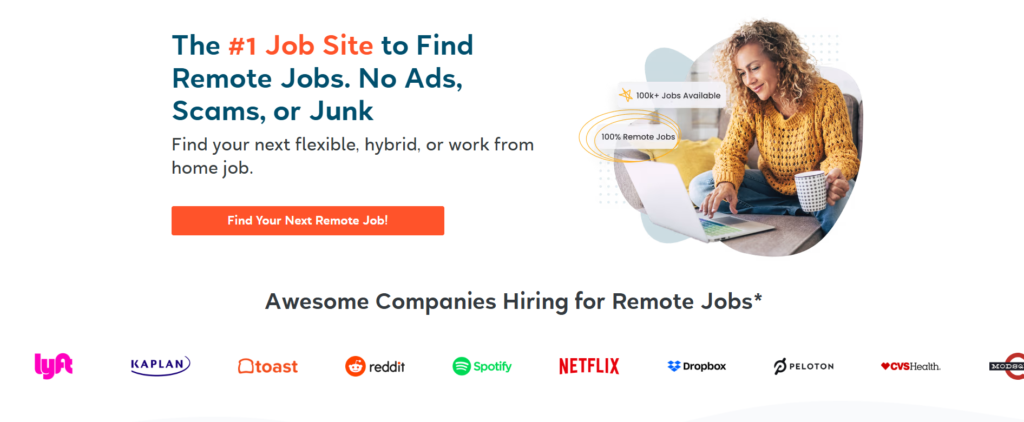
- Get started: Visit flexjobs
- Pros:
- + Curated listings ensure high-quality and legitimate jobs.
- + Wide range of remote, freelance, and flexible opportunities.
- + Advanced search filters make it easy to find suitable roles.
- Cons:
- – Requires a paid subscription to access full job details.
- – Limited direct communication with clients through the platform.
- – Smaller pool of freelance-specific jobs compared to competitors.
FlexJobs is a platform dedicated to curating high-quality and legitimate remote, freelance, and flexible job opportunities. It stands out because every job listing is carefully screened to ensure it’s free from scams, making it an excellent choice for freelancers who prioritize security and professionalism.
The platform features advanced search filters, allowing freelancers to find roles that match their skills, industries, and availability. FlexJobs is particularly useful for freelancers seeking remote work in industries like writing, marketing, customer service, and technology. However, the platform requires a paid subscription to access full job details, which might deter freelancers who are just starting out or have a tight budget. Another limitation is its smaller pool of freelance-specific jobs compared to platforms like Upwork or Fiverr, as it also caters to remote full-time and part-time positions.
Despite these downsides, FlexJobs offers unparalleled job quality, ensuring freelancers don’t waste time on low-quality or fraudulent listings. For freelancers serious about finding reliable, high-paying work, the platform’s subscription fee is often a worthwhile investment.

